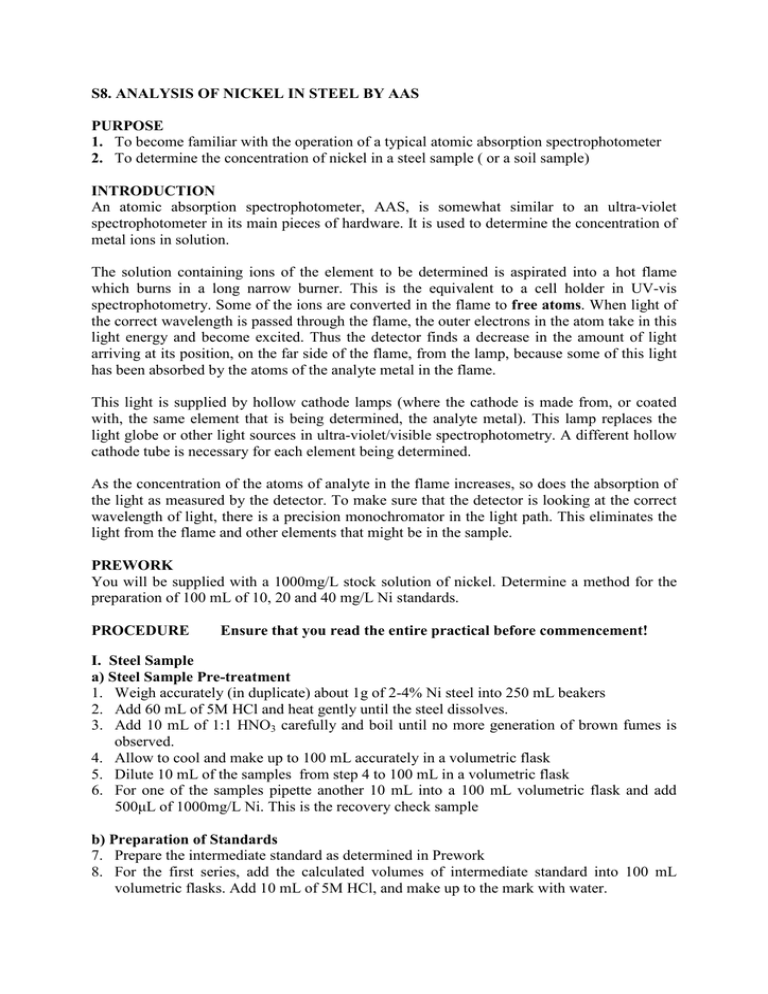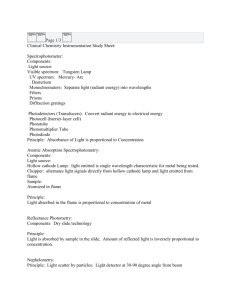S8. ANALYSIS OF NICKEL IN STEEL BY AAS PURPOSE
advertisement

S8. ANALYSIS OF NICKEL IN STEEL BY AAS PURPOSE 1. To become familiar with the operation of a typical atomic absorption spectrophotometer 2. To determine the concentration of nickel in a steel sample ( or a soil sample) INTRODUCTION An atomic absorption spectrophotometer, AAS, is somewhat similar to an ultra-violet spectrophotometer in its main pieces of hardware. It is used to determine the concentration of metal ions in solution. The solution containing ions of the element to be determined is aspirated into a hot flame which burns in a long narrow burner. This is the equivalent to a cell holder in UV-vis spectrophotometry. Some of the ions are converted in the flame to free atoms. When light of the correct wavelength is passed through the flame, the outer electrons in the atom take in this light energy and become excited. Thus the detector finds a decrease in the amount of light arriving at its position, on the far side of the flame, from the lamp, because some of this light has been absorbed by the atoms of the analyte metal in the flame. This light is supplied by hollow cathode lamps (where the cathode is made from, or coated with, the same element that is being determined, the analyte metal). This lamp replaces the light globe or other light sources in ultra-violet/visible spectrophotometry. A different hollow cathode tube is necessary for each element being determined. As the concentration of the atoms of analyte in the flame increases, so does the absorption of the light as measured by the detector. To make sure that the detector is looking at the correct wavelength of light, there is a precision monochromator in the light path. This eliminates the light from the flame and other elements that might be in the sample. PREWORK You will be supplied with a 1000mg/L stock solution of nickel. Determine a method for the preparation of 100 mL of 10, 20 and 40 mg/L Ni standards. PROCEDURE Ensure that you read the entire practical before commencement! I. Steel Sample a) Steel Sample Pre-treatment 1. Weigh accurately (in duplicate) about 1g of 2-4% Ni steel into 250 mL beakers 2. Add 60 mL of 5M HCl and heat gently until the steel dissolves. 3. Add 10 mL of 1:1 HNO3 carefully and boil until no more generation of brown fumes is observed. 4. Allow to cool and make up to 100 mL accurately in a volumetric flask 5. Dilute 10 mL of the samples from step 4 to 100 mL in a volumetric flask 6. For one of the samples pipette another 10 mL into a 100 mL volumetric flask and add 500µL of 1000mg/L Ni. This is the recovery check sample b) Preparation of Standards 7. Prepare the intermediate standard as determined in Prework 8. For the first series, add the calculated volumes of intermediate standard into 100 mL volumetric flasks. Add 10 mL of 5M HCl, and make up to the mark with water. 9. Repeat step 8 for a second step but also add, by measuring cylinder 10 mL of 10 g/L Fe solution 10. A blank with no nickel should be prepared for EACH set of standards. (Remember to add the acid and Fe as required to the blanks). III. Setting up the Spectrophotometer 11. Lookup the specifications for nickel in the operating manual for the instrument and find the following: • the wavelength of the resonance line suitable for the concentration of standards you have prepared • the fuel mixture • the lamp current • the recommended bandpass 12. Your teacher will demonstrate the starting procedure for the instrument. It is a relatively complex operation, so make sure you note the following: • switching on power • selecting and installing the lamp • setting lamp current • adjusting slit width • selecting and peaking resonance line on monochromator • aligning the lamp with respect to the detector • igniting the flame • optimising the burner position • selecting absorbance readout • zeroing instrument with de-ionised water 13. Read the absorbance of each series of standards (only one set if you have soil) and your samples. Repeat each reading at least twice, and use an average value for your graph. Allow the absorbance to return to zero between solutions, if it does not return you should reblank the instrument. 14. Run de-ionised water through the aspirator and flame for at least 30 seconds. 15. THERE IS ONLY ONE OPERATION THAT IS CRITICAL WHEN TURNING OFF AN AAS INSTRUMENT!!! THE FUEL (ie the acetylene) MUST BE TURNED OFF FIRST. 16. Once the flame is extinguished, the oxidant (ie the air) can be turned off, and then all the power switches. CALCULATIONS 1. Plot calibration graphs for the standards 2. Determine the concentration of your samples from both graphs 3. For the recovery check sample determine the % recovery. 4. Apply the dilution factor to determine the original concentration of the solution 5. Calculate the mass of nickel in the original solution, and use this to determine the %w/w of nickel in the sample 6. Calculate the sensitivity of the resonance line used (equal to 0.0044 / slope of the graph), and compare to the specification value DISCUSSION • discuss the reasons for adding HCl to the blank and standards. • for the steel sample compare the results from the two calibration graphs and discuss for reasons for any differences in the values. QUESTIONS 1. Under what conditions would you rotate the burner to reduce the absorbance readings? 2. Explain why the following solutions would cause problems with AA instruments: a) very viscous b) containing suspended solids c) containing dissolved gases 3. Explain the combination of flame gases you would use for: a) calcium b) sodium S8. RESULTS SHEET Date of analysis Identity of instrument From Instrument Manual Wavelength of suitable resonance line (nm): Fuel mixture: Fuel Stoichiometry: Recommended bandpass (nm): Sensitivity of resonance line (mg/L): Lamp current Sample analysis Sample code: Sample mass 1 (g) Sample mass 2 (g) Solution Blank 10 mg/L (no Fe) 20 mg/L (no Fe) 40 mg/L (no Fe) Blank (with Fe) 10 mg/L (with Fe) 20 mg/L (with Fe) 40 mg/L (with Fe) Sample 1 Sample 2 Recovery check Have you? Absorbances Ave. abs. 0.000 Date Signature Completed the instrument log Completed the sample register Completed the standard register Teachers signature

